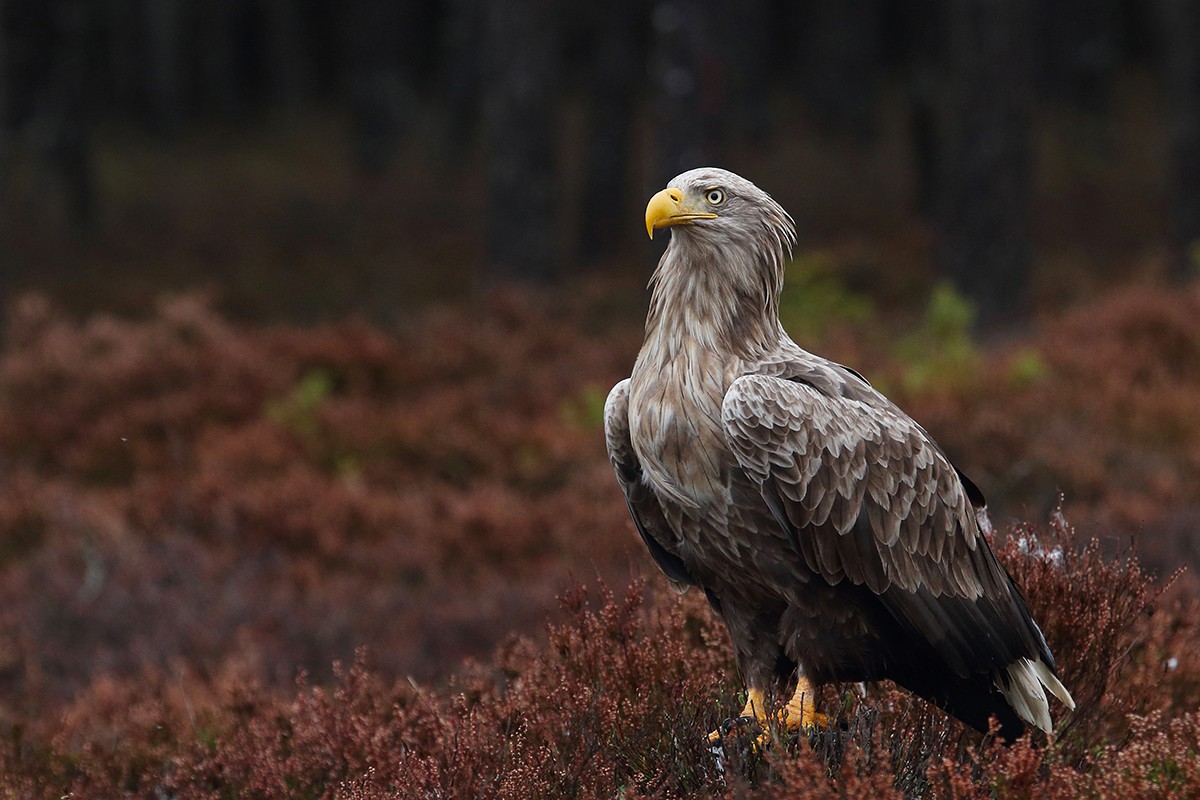White-tailed Eagle
A species of Sea eagles Scientific name : Haliaeetus albicilla Genus : Sea eagles
White-tailed Eagle, A species of Sea eagles
Botanical name: Haliaeetus albicilla
Genus: Sea eagles
 Photo By Karl Adami , used under CC-BY-SA-4.0 /Cropped and compressed from original
Photo By Karl Adami , used under CC-BY-SA-4.0 /Cropped and compressed from original Description
The white-tailed Eagle is a large raptor that soars on wind currents. Adults, four years and older, sport distinguishable white tail feathers. The raptor is often seen flying along coastlines and rivers where it hunts for fish. The bird also takes prey from other birds and mammals and often switches to carrion in the winter.
Size
79 - 102 cm
Colors
Brown
Black
Gray
Life Expectancy
20 years
Nest Placement
Tree
Feeding Habits
White-tailed Eagle maintains a diverse, opportunistic diet including fish, birds, and mammals. Primarily scavengers in winter, they exploit carrion and steal food from otters and birds, utilizing sharp vision to locate meals.
Habitat
White-tailed Eagle thrives in various aquatic settings, favoring environments near water bodies like seas and freshwater systems including lakes and rivers. Their habitats range from desert edges to Arctic zones, always in surroundings with minimal human activity. Nesting and resting require sea cliffs or wooded areas with tall trees, mainly in lowland regions near the coast or substantial water sources.
Dite type
Piscivorous
People often ask
Migration Overview
The white-tailed eagle may be considered a rather inconsistent and partial migrant. The species seldom migrates in the western part of its range, with eagles even breeding as far north as Greenland, Iceland and coastal Norway not moving at all for winter, but for some southward juvenile movements following dispersal. Juveniles overall are more migratory and dispersive and leave natal areas sooner, which is by August–September in northwestern Europe and return later, by March/April, than adults do. Few Norwegian juveniles, per banding studies, were recorded to travel any considerable distance. Extreme cases include one that was found 720 km (450 mi) south of its nest near Karlstad, Sweden, another set of 4 color marked 1st year juveniles were also recorded to turn up in southern Sweden but one was found down to the Wadden Sea in the Netherlands and it is likely that trickling down numbers of Norwegian post-dispersal juveniles have gone onto form much of the known Dutch white-tailed eagle population. In contrast, young from Finland and Sweden tend to distribute to the southwesterly direction to the shores of the Baltic sea. One from Finland was recovered 520 km (320 mi) west in northern Norway and another was found as far south as Bulgaria. In more southerly areas, winter movements are drawn-out and irregular, with most mature pairs probably never leaving their nesting haunts year-around. Those that breed on inland waterways may migrate to sea coast. German juveniles usually do not travel far, with most recorded to travel less than 50 km (31 mi) from their nests and a majority staying near the Baltic coast. However, some eagles that hatched from nests in Germany have been found as far south as in Italy, 1,030 km (640 mi) away to the southeast, or to Gironde, France, 1,520 km (940 mi) to the southwest. In several parts of Russia, quite unlike many European populations, the white-tailed eagle seems to be largely migratory. In the far east, the species appear to take different migratory routes in fall and spring, traveling from north-central Kamchatka thru the Kurile islands to Hokkaido in fall, while in spring these eagles travel north through Sakhalin and the Okhotsk Coast. In the White Sea area, southward moments begin in September with most white-tailed eagles being gone by November but in mild winters some adults may remain behind. Some white-tailed eagles from the White Sea were found well over 2,000 km (1,200 mi) away to the west, in countries such as Hungary and Italy. Return spring migration to the White Sea is by February–March. During winter, whether long-distance migrants or short-distance dispersers, white-tailed eagles tend to become gregarious, especially younger juvenile birds. Many such groups can contain up to 10 and, in areas near large breeding populations such as in Norway, at least 30-40 individuals. Wintering congregations at the Baltic coast and on the River Elbe from 37 winters show that arrivals begin in November, with numbers peaking in January and then declining during March and early April. Although juveniles usually return to their natal area some apparently overshoot these areas, such as those returning to Romania or on the Black Sea which have been recorded 330 km (210 mi) north of their natal site and 510 km (320 mi) northeast of their natal site. 
General Info
Feeding Habits
Bird food type
Behavior
White-tailed eagles spend much of their day perched on trees or crags, and may often not move for hours. Perhaps up to 90% of a day may be spent perched, especially if weather is poor. Also, they will alternate periods of soaring with perching, especially flying over water or well-watered areas, but do considerably less soaring on average than do golden eagles. Pairs regularly roost together, often near to their nest, either on a crag or tree or crevices, overhung ledges or small isolated trees on a crag. 
Species Status
In Sweden, brood size has varied from 1.3 per nest prior to 1950, down to 0.3 in 1965–1985. Now the brood sizes have increased, at somewhat less than 1 brood size on average, but still somewhat less productivity than historical numbers. In several parts of the European range, especially southern Scandinavia and central Europe, protections have allowed white-tailed eagles to recolonize former parts of their range. 